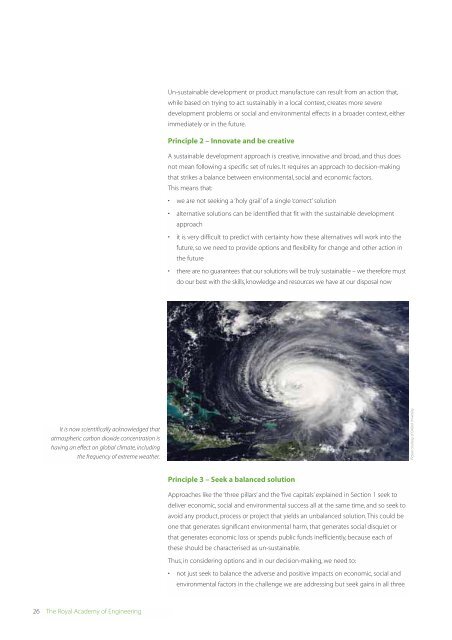Engineering for Sustainable Development: Guiding Principles
Engineering for Sustainable Development: Guiding Principles
Engineering for Sustainable Development: Guiding Principles
Create successful ePaper yourself
Turn your PDF publications into a flip-book with our unique Google optimized e-Paper software.
Un-sustainable development or product manufacture can result from an action that,<br />
while based on trying to act sustainably in a local context, creates more severe<br />
development problems or social and environmental effects in a broader context, either<br />
immediately or in the future.<br />
Principle 2 – Innovate and be creative<br />
A sustainable development approach is creative, innovative and broad, and thus does<br />
not mean following a specific set of rules. It requires an approach to decision-making<br />
that strikes a balance between environmental, social and economic factors.<br />
This means that:<br />
• we are not seeking a ‘holy grail’ of a single ‘correct’ solution<br />
• alternative solutions can be identified that fit with the sustainable development<br />
approach<br />
• it is very difficult to predict with certainty how these alternatives will work into the<br />
future, so we need to provide options and flexibility <strong>for</strong> change and other action in<br />
the future<br />
• there are no guarantees that our solutions will be truly sustainable – we there<strong>for</strong>e must<br />
do our best with the skills, knowledge and resources we have at our disposal now<br />
It is now scientifically acknowledged that<br />
atmospheric carbon dioxide concentration is<br />
having an effect on global climate, including<br />
the frequency of extreme weather.<br />
Picture courtesy of Ox<strong>for</strong>d University<br />
Principle 3 – Seek a balanced solution<br />
Approaches like the ‘three pillars’ and the ‘five capitals’ explained in Section 1 seek to<br />
deliver economic, social and environmental success all at the same time, and so seek to<br />
avoid any product, process or project that yields an unbalanced solution. This could be<br />
one that generates significant environmental harm, that generates social disquiet or<br />
that generates economic loss or spends public funds inefficiently, because each of<br />
these should be characterised as un-sustainable.<br />
Thus, in considering options and in our decision-making, we need to:<br />
• not just seek to balance the adverse and positive impacts on economic, social and<br />
environmental factors in the challenge we are addressing but seek gains in all three<br />
26 The Royal Academy of <strong>Engineering</strong>
















